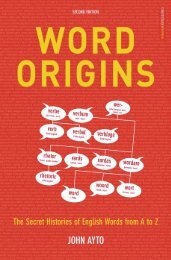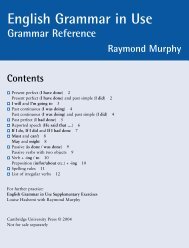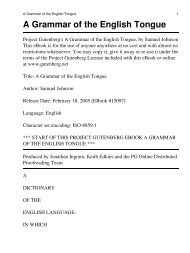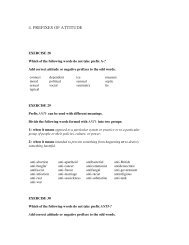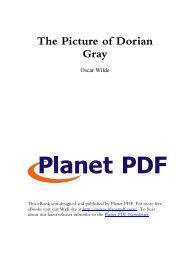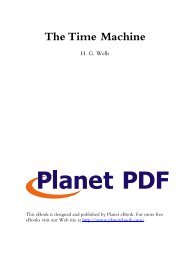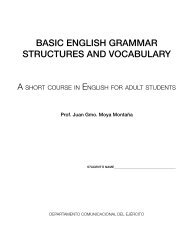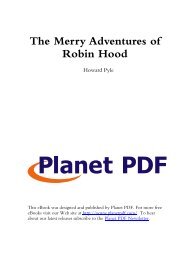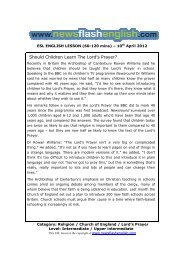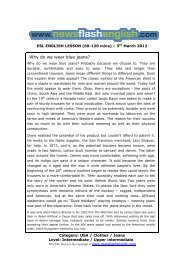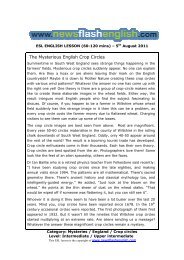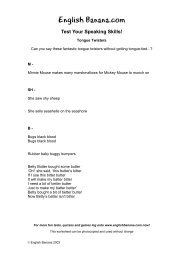TO DOWNLOAD - 75 Pages (928kb - PDF format) - ESL Teachers ...
TO DOWNLOAD - 75 Pages (928kb - PDF format) - ESL Teachers ...
TO DOWNLOAD - 75 Pages (928kb - PDF format) - ESL Teachers ...
Create successful ePaper yourself
Turn your PDF publications into a flip-book with our unique Google optimized e-Paper software.
RHE<strong>TO</strong>RICAL SKILLSPARALLEL:Modern classical music is neither inspiring norfulfilling (Two parallel adjectives).AWKWARD:Not only are the gang members spraying graffitiall over the brick walls of the campus but also inadjacent residential neighborhoods. (A clausemade parallel with a prepositional phrase.)PARALLEL:Not only are the gang members spraying graffitiall over the brick walfof the campus, but they arealso spraying in adjacent neighborhoods. (Twoparallel clauses.)Maintain parallelism in sentences that have two or moreequal ideas.34 DOCUMENTATIONStudents writing term papers for the first time should beaware that documentation is as important as the contentof their paper. What is more, the quality of the documentation,of its form and exactness, usually signifies thegeneral worth and credibility of the paper.WHAT DO YOU DOCUMENT?You document, that is, reveal the source of, any idea thatyou borrowed, any quotation, any facts, data/charts, orStatistics, or narratives. In addition, you must acknowledgeany idea that you borrow, any line of thought, orany original phrase or sentence,WHY DO YOU DOCUMENT?You document to avoid plagiarism, or representation ofsomeone else's work as your own, an easy mistake tomake when you are writing a term paper based on a largenumber of secondary sources. You document sources tolet your reader know where you got your in<strong>format</strong>ionand how current it is in the event that the reader wants tobuild on your thesis and carry it forward. For this reason,careful documentation can be considered the heart andsoul of scholarship. Finally, you document your sourcesbecause you wish to make your work more convincingand substantial; this is the evidence that hammers homeyour point and renders your work authoritative.34A BIBLIOGRAPHYA bibliography is simply a list of books, journal articles,and other research materials related to a particularsubject. Bibliographies can be either generalized or specific.For example, there are bibliographies that are collectionsof titles on wheat production, or collections ofbiographies, or collections of book titles on hunting, orcollections of criticisms on Charles Dickens' novels, oreven collections of critical articles about one of his novels,such as Great Expectations. The sources actuallycited and listed alphabetically on a separate sheet at theend of the paper is called References in the APA(American Psychological Association) style of documentation,Works Cited in the MLA (Modern LanguageAssociation) style, and Bibliography in CMS (ChicagoManual of Style) style. If you list all the books you haveread as background, regardless of whether or not youhave cited them within the text of your document, youmay call the list Bibliography in the APA style or WorksConsulted in the MLA style; the CMS allows SourcesConsulted, Works Cited, or Selected Bibliography, ifthey better describe your list. The list of notes correspondingto the superscript numerals in the CMS methodof documentation is called Notes.34B MLA documentationThe style of documentation described in the MLAHandbook for Writers of Research Papers* uses parentheticalcitations in the written material to document allsources of quotations, paraphrased statements, ideas, orother secondary sources. These parenthetical citationsrefer to a list of Works Cited, a complete and detailed listof references at the end of the paper. Typically, theauthor's name is mentioned in a sentence that introducesthe material, and a page number in parentheses is givenat the end of the sentence. For more in<strong>format</strong>ion aboutthe source, all the reader has to do is find the author'sname in the Works Cited page at the end of the essay.MLA style also permits the addition of a series ofexplanatory notes for explanation or interpretation.Superscript (or raised) numbers are used in the essay torefer readers to a list of notes that follows the end of thereport under the beading of NOTES. For full in<strong>format</strong>ionabout the MLA style, consult the official MLA stylemanual in your library or bookstore.EXAMPLES:Of a citation in the text:Howard Lear concludes that William Faulkner wasvery fond of the residents of YoknapatawphaCounty, even though he frequently cast moralaspersions upon them (1 1 8).Of an entry in the Works Cited list:Osborne, David, and Ted Gaebler. ReinventingGovernment: How the Entrepreneurial SpiritIs Transforming the Public Sector. Reading:Addison, 1992.DOCUMENTING SOURCES WITHIN THE TEXTMLA textual references can be made in three ways:1. By citing the author's last name and the page numbersof the source in parentheses.Some major critics argue that the emphasis onlinguistics and the dynamics of language broughtforward by the newest critical modes may spell arenaissance in modern poetry (Waller 28).2. By referring to the author in the text and placing onlythe page numbers in parentheses.*Gibaldi, Joseph. MLA Handbook for Writers of Research Papers. 4thed. New York: MLA, 1995.55



